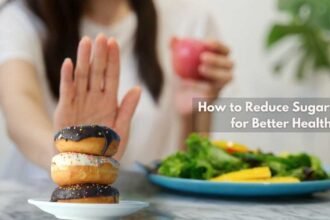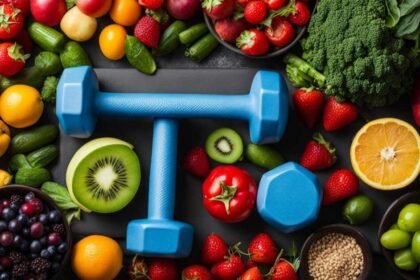Reduce Sugar Intake for Better Health : Have you ever grabbed a sugary snack after a long day, only to feel more tired? We’ve all done it. The ups and downs in energy can make us want more sugar, starting a cycle that’s tough to stop. But, there are easy ways to cut down on sugar and eat healthier for better nutrition. A sugar detox might be the step we need for more energy and a better life.
We’re used to a lot of sugar in our daily foods and drinks. Studies show Americans eat 55-92 grams of added sugar a day, which is 13-22 teaspoons. That’s 12-16% of our daily calories1. These numbers are high, especially when the World Health Organization says we should aim for less than 5% of daily calories from added sugar1. So, it’s crucial to take steps to reduce sugar in our diets.
We can begin with small changes, like drinking water or unsweetened tea instead of soda2. Choosing foods with less sugar by reading labels carefully can also help2. Swapping added sugar in cereals with fruit sugars is another easy tip2. These changes can lead to a healthier diet and better nutrition.
Key Takeaways
- Americans consume between 55-92 grams of added sugar daily, making up 12-16% of their daily calories1.
- The World Health Organization recommends reducing added sugar intake to less than 5% of daily calories for optimal health1.
- Unsweetened beverages like water or unsweetened iced tea are suggested alternatives to sugary drinks2.
- Reading and comparing Nutrition Food labels can help in selecting products with the lowest amounts of added sugars2.
- Natural sugars from fruits can replace added sugars in cereals and oatmeal2.
Understanding the Impact of Sugar on Health
Sugar has big effects on our health. It can lead to heart disease, obesity, and diabetes. It also affects our mental health. Let’s look at the health risks of eating too much sugar.
Health Risks Associated with High Sugar Intake
Eating too much sugar is bad for many reasons. Drinking sugar-sweetened drinks is linked to obesity, type 2 diabetes, and heart disease. This has led to more people getting these conditions worldwide.
In the U.S., adults eat about 17 teaspoons of added sugar a day. This makes up 14% of their daily calories3. This habit can raise blood sugar and blood pressure, increase inflammation, and raise triglycerides. These are all risk factors for heart disease and obesity3.
High sugar diets are also bad for our mental health. Men who eat 67 grams or more of sugar a day are 23% more likely to feel depressed3. Women who eat more sugar also have a higher risk of depression3. Drinking more than eight sugar-sweetened drinks a week can even increase the risk of stroke3.
Advanced Glycation End Products (AGEs) form when sugar reacts with proteins. This can cause skin to age too quickly by damaging collagen and elastin3. AGEs come from eating too many refined carbs and sugars. This shows why eating less sugar is important for staying healthy.
Recommended Daily Sugar Intake
It’s important to know how much sugar we should eat to avoid health problems. The guidelines say we should limit added sugar to less than 10% of our daily calories3. Here are the sugar limits for different age groups:
- Adults: No more than 30g of free sugars daily, roughly equivalent to 7 sugar cubes4.
- Children aged 7-10: No more than 24g of free sugars daily, approximately 6 sugar cubes4.
- Children aged 4-6: No more than 19g of free sugars daily, equivalent to 5 sugar cubes4.
It’s also key to read nutritional labels. If a label shows more than 22.5g of sugar per 100g, it’s high. Less than 5g per 100g is low sugar4. Following these guidelines helps keep our diets healthy and lowers sugar risks.
For more info on sugar and health, check out the research on the impact of sugar on health4.
Identify Sources of Added Sugars
It’s key to know where added sugars come from in our diet to cut down on sugar and follow a low-sugar diet. Many processed foods like sauces, breakfast items, and drinks have a lot of added sugars. These sugars are often hidden and can harm our health.
Hidden Sugars in Common Foods and Drinks
Many everyday foods have hidden sugars. For example, breakfast cereals, bars, and instant oatmeal can have up to 18 grams of added sugar per serving5. Drinks like a 12-ounce can of cola have about 39 grams of sugar, which is 9.75 teaspoons6. Soft drinks make up 16% of the sugar we get from sweetened drinks6.
Don’t forget about foods like sauces and dressings that are full of hidden sugars. Breakfast cereals and bars add 7% of added sugars, and sweet snacks add 19%6. Foods like desserts, cakes, and sweet drinks are also big sources6.
Reading and Understanding Food Labels
Looking at food labels helps us control sugar intake. The new Nutrition Facts label shows “Total Sugars” and “Added Sugars” to help us make better choices5. The Dietary Guidelines for Americans 2020-2025 suggest limiting added sugar to less than 10% of our daily calories5. For a 2,000 calorie diet, that’s about 50 grams or 12 teaspoons of added sugar5.
Knowing the different names for sugars like glucose, fructose, or sucrose helps us avoid hidden sugars. Choosing whole and full-fat foods over processed, low-fat ones can also cut down on sugar. By carefully reading labels and picking fewer processed foods, we can greatly reduce our sugar intake and support a low-sugar diet.
| Source | Percentage of Added Sugars |
| Desserts & Beverages | 24% |
| Sweetened Snacks | 19% |
| Coffee & Tea | 11% |
| Other Sources | 19% |
Practical Tips for Reducing Sugar in Your Diet
Adding sugar reduction tips to our daily life can make our diet healthier and improve our health over time. One key area to focus on is our drink choices.
Swapping Sugary Beverages for Healthier Options
Swapping sugary drinks for healthier ones is a great way to cut down on sugar. Switching from sugary cola to diet options can save 796 teaspoons of sugar, or 12,649 calories, in three months7. Choosing no-added-sugar squash or cordial can save 555 teaspoons of sugar and 8,880 calories in the same time7. Unsweetened sparkling water, herbal teas, and plain water are great choices for a healthier diet.
Choosing Natural Sweeteners
If you’re finding it hard to give up sweet tastes, try natural sweeteners like stevia. Using natural sweeteners or flavor extracts can help manage sugar cravings. Replacing sugar in tea, coffee, cereal, and porridge with stevia can save 90 teaspoons of sugar and 1,440 calories over three months7. Choosing natural yogurt over low-fat fruit yogurt saves another 351 teaspoons of sugar and 5,616 calories7.
Other good changes include using whole fruits or mashed bananas as sweeteners in recipes. This cuts down on added sugars and boosts nutrition. The American dietary guidelines suggest eating less than 50 grams of added sugar a day, showing how important these swaps are8. By following these tips, we can greatly improve our health and well-being.
Benefits of a Low-Sugar Diet
Choosing a low-sugar diet can bring many health perks. It helps with weight control and boosts heart health.
Weight Management
One big plus of a sugar detox is its help with losing weight. Cutting down on added sugars means eating fewer calories. This can lead to losing one to two pounds each month9.
Added sugars in foods often add empty calories. These can cause quick weight gain and health problems10. Staying under 10% of daily calories from added sugars helps control weight better10.
Improved Heart Health
A diet low in sugar is great for the heart. It can lower blood pressure and reduce inflammation. This makes the heart work better and keeps triglyceride levels down10.
Keeping sugar below 20% of daily calories is linked to lower triglyceride levels. This lowers the risk of heart disease10. The American Heart Association suggests men eat no more than 9 teaspoons of sugar a day. Women should aim for 6 teaspoons to avoid health problems119.
Eating too much sugar can lead to weight gain. This puts more strain on the heart and increases the risk of heart disease11. Eating less sugar can also reduce depression and anxiety. This makes for a healthier heart and overall well-being9.
Learning about the benefits of a low-sugar diet helps us make better choices. Articles at Health.com can guide us towards better health.
Cutting Down on Sugary Snacks and Desserts
Reducing our intake of sugary snacks and desserts is key to a healthier diet. On average, Americans eat 22 teaspoons of added sugar daily, which is about 350 empty calories12. Foods like candies, baked goods, and ice creams are big contributors to this sugar intake.
Switching high-sugar treats for healthier, lower-sugar options helps us satisfy our cravings and cut down on sugar. For example, choosing fresh fruits over candies gives us natural sweetness with vitamins and fiber. Greek yogurt with fresh berries or a bit of honey is another great choice. It’s a nutritious snack that’s low in added sugars.
Dark chocolate is also a good sugar-free treat. It has less sugar than milk chocolate and is full of antioxidants. It’s a better pick for those wanting to eat less sugar. Remember to watch your portion sizes and pick products with less sugar, as shown on the label.
The Dietary Guidelines for Americans suggest limiting added sugars to less than 10% of daily calories for people over 2 years old13. This means about 12 teaspoons of added sugar for a 2,000-calorie diet. This guideline supports choosing sugar-free treats and healthier snacks.
Here’s a look at some popular sugary snacks and their healthier alternatives:
| Sugary Snack | Healthier Alternative | Sugar Content |
| Milk Chocolate (1 oz) | Dark Chocolate (1 oz) | 14g vs. 5g |
| Soda (12 oz) | Unsweetened Tea | 39g vs. 0g |
| Ice Cream (1 cup) | Greek Yogurt with Berries | 28g vs. 12g |
| Fruit-Flavored Yogurt (8 oz) | Plain Greek Yogurt | 19g vs. 5g |
In conclusion, picking healthier snacks and sugar-free treats can greatly reduce our sugar intake. This leads to a healthier lifestyle. Let’s make smart choices to swap sugary snacks for better ones and see how it improves our health and well-being.
Incorporating More Whole Foods
Moving to a diet full of whole foods is key to eating healthy and improving nutrition. Whole foods like veggies, fruits, beans, whole grains, and lean meats are packed with nutrients and low in added sugars1415. Adding more whole foods to our meals helps us eat less sugar and get more nutrients.

Eating meals based on foods like potatoes, bread, rice, and pasta is good for a balanced diet14. It’s also important to eat at least five fruits and veggies every day for better health14. Eating fresh, canned, or frozen produce can lower the risk of serious diseases like cancer and heart disease15.
Choosing a whole food diet means avoiding foods that are highly processed. These foods can lead to heart problems and other health issues15. Eating whole grains can help reduce belly fat compared to eating refined grains15. Whole foods are also less likely to have harmful additives, making them a better choice for staying healthy.
It’s also crucial to eat fewer refined carbs, which can cause inflammation, insulin resistance, and obesity15. By focusing on whole foods, we cut down on sugar and boost our nutrient intake. This supports our health now and in the future.
How to Reduce Sugar Intake for Better Health
Reducing sugar intake is key for better health. It needs a strategic plan for long-term success.
Develop a Sugar Reduction Plan
Start by setting clear goals for cutting sugar. Look for ways to make diet changes. For instance, swap sugary snacks and drinks for healthier ones.
Kids take in over two times the sugar they should, mostly from snacks and drinks16. Use apps like the NHS Food Scanner to track sugar in foods and find healthier options16. Women should aim for less than triple the daily sugar limit, and men less than double17.
Seek Support and Professional Guidance
Getting help from experts can greatly aid in reducing sugar. Dietitians and healthcare providers offer advice suited to you. Joining support groups or online forums can also boost motivation and share experiences.
Many foods and drinks have a lot of added sugars, leading to too much sugar intake18. Learning to read food labels and getting expert advice helps overcome these challenges. A big part of kids’ daily sugar comes from sugary drinks, showing the importance of good dietary advice16.
For more info on diet changes and strategies, visit professional nutrition advice and learn how to cut sugar intake effectively.
Clever Cooking Hacks to Reduce Sugar Usage
Using new cooking methods is key to cutting sugar in our diets without losing flavor. By picking spices and herbs, and swapping out ingredients, we can make tasty meals that are also healthy. These changes boost the natural taste of food while sticking to recipes with less sugar.
Using Spices and Herbs
Adding different spices and herbs can cut down on sugar in our cooking. For instance, spices like cinnamon, nutmeg, ginger, cloves, and cardamom make food taste better without needing more sugar19. Vanilla extract is great too, as it makes milk taste sweeter without sugar19. Herbs like mint, basil, and rosemary add unique flavors that fill in for sugar.
Substituting Ingredients
Swapping out traditional sugars for healthier options can change the game in baking or cooking. Options like mashed bananas, pureed dates, unsweetened applesauce, or canned pumpkin add sweetness and moisture to foods, cutting down on fat19. Whole fruits like berries and apples bring a natural boost to recipes19.
Dried fruits like raisins, dates, figs, and prunes add sweetness but check for sugar content19. Roasted veggies like sweet potatoes, acorn squash, carrots, and parsnips show off their sweet side and are great for savory dishes with a touch of sweetness19. These choices help lower sugar in our homemade meals.
These smart cooking tricks make it simpler to follow reduced-sugar recipes every day. For more tips on making your meals better, see this guide from Health Point Plaza. Using these methods makes eating healthier and more fun.
Avoiding Sugary Breakfast Foods
Many breakfast foods are full of added sugars, making them bad for your health. Choosing low-sugar options with protein and fiber can help you stay full and give you energy all day.
Low-Sugar Breakfast Alternatives
There are many tasty, healthier breakfast choices. You can try oatmeal, Greek yogurt with nuts, eggs with veggies, or avocado on whole-grain toast. These foods are low in sugar but high in fiber and protein, making them great for a healthier diet.
The Importance of Protein and Fiber in Breakfast
Adding protein and fiber to your breakfast is key for staying energized and healthy. Foods high in these nutrients make you feel full, helping you avoid sugary snacks later. A balanced breakfast also keeps your sugar levels in check, which is good for your long-term health.
| Food | Benefits |
| Oatmeal | High in fiber, helps reduce cholesterol levels |
| Greek Yogurt with Nuts | Rich in protein and healthy fats |
| Eggs with Vegetables | Excellent source of protein and vitamins |
| Avocado on Whole-Grain Toast | High in fiber and healthy fats |
Studies show that eating a lot of added sugar can lead to anxiety and depression20. Cutting down on sugar can also lower the risk of heart disease and other chronic conditions21. Choosing a protein-rich breakfast with lots of fiber is a big step towards eating healthier.
Mindful Eating and Sugar Cravings Management
Mindful eating helps us manage cravings and control sugar intake. It makes us focus on the now and understand our eating habits. This way, we can make choices that are better for our health.
Understanding and Managing Cravings
Cravings come from both physical and emotional reasons. Studies show that most obese people are women, showing how mindful eating affects them differently22. Mindful eating lets us recognize these triggers without acting on them right away. This helps us handle cravings better.
People who tried mindfulness saw better eating habits and kept their blood sugar stable22. This shows how effective it can be.
Mindfulness Techniques to Curb Sugar Intake
Mindfulness can help us eat less sugar and eat better. Techniques like deep breathing and eating slowly make us more aware of our eating. A study found a link between sugary drinks and obesity, showing why controlling sugar is key23.
Less sugar means more energy and a lower risk of chronic diseases24. People who practiced mindfulness ate less candy and showed better eating habits22. These techniques help us think more about our food choices, leading to better health and managing sugar cravings.

Conclusion
Reducing sugar intake is key to a healthier life. It lets us make choices that boost our health. By knowing how sugar affects us, from causing obesity and heart disease to diabetes and tooth decay, we see why cutting down is urgent25. Learning about hidden sugars in foods and drinks helps us avoid them26.
Small changes can make a big difference. Swapping sugary drinks for healthier ones, using natural sweeteners, and eating more whole foods are good steps. These changes are easy to start and can lead to big health benefits like better heart health and managing weight2625.
Reducing sugar is a long-term goal, not just a trend. By sticking to these tips, we can live healthier lives. Strategies like taxes and changing food environments help us cut down on sugar. These efforts make it easier and more effective to reduce sugar intake26. Let’s choose healthy living and make choices that benefit us for a long time.
FAQ
What are some effective ways to reduce sugar intake?
Reducing sugar intake means cutting down on the sugar you add to your food and drinks. Choose water over sweetened drinks and pick products with less sugar. Adding fruits for sweetness can also help.
These steps can greatly lower your sugar intake and improve your health.
What are the health risks associated with high sugar intake?
Eating too much sugar is linked to serious health problems. These include obesity, type 2 diabetes, heart disease, cancer, and dental issues. It can also lead to weight gain and spikes in blood sugar, making these conditions worse.
How much sugar is recommended for daily intake?
The Dietary Guidelines for Americans suggest keeping added sugars under 10% of your daily calories. The World Health Organization recommends keeping it below 5%. These guidelines aim to reduce health risks from too much sugar.
Where are hidden sugars commonly found in foods and drinks?
Hidden sugars are often in processed foods like sauces, breakfast items, and drinks. Many of these products have a lot of added sugars that people don’t know about. Reading food labels can help spot these hidden sugars.
How can I read and understand food labels to identify added sugars?
It’s important to know how to read food labels to find added sugars. Look for names like glucose, fructose, or sucrose. Choose products labeled as low in added sugars or without them to cut down on sugar.
What are some healthier options for sugary beverages?
Instead of sugary drinks, try water, unsweetened sparkling water, or herbal teas. These options have much less sugar and are better for your health.
Can natural sweeteners be used in place of sugar?
Natural sweeteners like stevia can be good alternatives to sugar. They add sweetness without the sugar and can help manage sugar cravings over time.
What are the benefits of a low-sugar diet?
Eating less sugar can help with weight management and lower the risk of heart conditions. It can also improve blood sugar control, reduce inflammation, lower blood pressure, and boost heart health.
How can I cut down on sugary snacks and desserts effectively?
To eat less sugar, cut down on snacks and desserts that are high in sugar. Replace them with healthier options like fresh fruits, Greek yogurt, and dark chocolate.
How can incorporating more whole foods help in reducing sugar intake?
Switching to a diet full of whole foods can reduce sugar intake and increase essential nutrients. Whole foods like vegetables, fruits, legumes, whole grains, and lean meats offer many health benefits and support a natural diet.
How can I develop a sugar reduction plan?
To reduce sugar, set clear goals and identify where you can cut sugar. Track your progress and get support from dietitians, healthcare providers, or groups.
What are some clever cooking hacks to reduce sugar usage?
Use spices and herbs to make foods taste better without sugar. Replace sugar with unsweetened applesauce or ripe bananas in baking. These tricks add new flavors and cut sugar content.
What are some low-sugar breakfast alternatives?
Try oatmeal, Greek yogurt with nuts, eggs with veggies, or avocado on whole-grain toast for a low-sugar breakfast. These options are high in protein and fiber, helping to keep sugar levels healthy.
How can mindful eating help manage sugar cravings?
Mindful eating helps understand what triggers cravings. By being more aware of your eating habits, you can better control sugar intake and develop a healthier relationship with food.
Source Links
- 13 Simple Ways to Stop Eating Lots of Sugar – https://www.healthline.com/nutrition/14-ways-to-eat-less-sugar
- Tips for Cutting Down on Sugar – https://www.heart.org/en/healthy-living/healthy-eating/eat-smart/sugar/tips-for-cutting-down-on-sugar
- 11 Reasons Why Too Much Sugar Is Bad for You – https://www.healthline.com/nutrition/too-much-sugar
- Sugar: the facts – https://www.nhs.uk/live-well/eat-well/food-types/how-does-sugar-in-our-diet-affect-our-health/
- Added Sugar – https://nutritionsource.hsph.harvard.edu/carbohydrates/added-sugar-in-the-diet/
- Understanding Added Sugars: Identifying and Reducing Your Intake – https://ourfamilyhealthcenter.com/blog/understanding-added-sugars/
- How to cut back on sugar without noticing – https://www.bhf.org.uk/informationsupport/heart-matters-magazine/nutrition/sugar-salt-and-fat/how-to-cut-back-on-sugar-without-noticing
- 15 Ways to Eat Less Sugar—Without Missing It – https://www.eatingwell.com/article/7914285/ways-to-eat-less-sugar-without-missing-it/
- Benefits of reducing sugar intake – Mather Hospital – https://www.matherhospital.org/weight-loss-matters/benefits-of-reducing-sugar-intake/
- What Happens When You Cut Out Added Sugar? – https://www.webmd.com/diet/ss/slideshow-effects-cut-added-sugar
- 5 Surprising Benefits to Cutting Down on Sugar – https://thenosugarcompany.com/blogs/knowledge/benefits-of-cutting-down-sugar
- Reducing Added Sugar Intake | Howdy Health – https://howdyhealth.tamu.edu/reducing-added-sugar-intake/
- Cut Down on Added Sugars – https://health.gov/sites/default/files/2019-10/DGA_Cut-Down-On-Added-Sugars.pdf
- 8 tips for healthy eating – https://www.nhs.uk/live-well/eat-well/how-to-eat-a-balanced-diet/eight-tips-for-healthy-eating/
- 11 Simple Ways to Eat Whole Today – https://www.healthline.com/nutrition/11-ways-to-eat-clean
- Reducing sugar – Food facts – Healthier Families – https://www.nhs.uk/healthier-families/food-facts/sugar/
- Here’s How to Cut Down on Sugar – https://www.webmd.com/diet/ss/slideshow-how-cut-back-sugar
- Sugar – https://www.healthdirect.gov.au/sugar
- 5 sugar-free ways to make your food (and life) sweeter – https://www.alaskaregional.com/blog/entry/5-sugar-free-ways-to-make-your-food-and-life-sweeter
- 30-Day No Sugar Challenge: Benefits, What to Expect, and More – https://www.healthline.com/nutrition/30-days-no-sugar
- How To Stop Eating Sugar: Tips, Swaps, and Cravings – https://zoe.com/learn/how-to-stop-eating-sugar
- Effects of a mindfulness-based intervention on mindful eating, sweets consumption, and fasting glucose levels in obese adults: data from the SHINE randomized controlled trial – https://www.ncbi.nlm.nih.gov/pmc/articles/PMC4801689/
- 5 Effective Ways to Curb Sweet Cravings – DHW Blog – https://dhwblog.dukehealth.org/5-effective-ways-to-curb-sweet-cravings/
- How to Break Your Sugar Addiction in 10 Days? – https://www.niagararecovery.com/blog/how-to-break-your-sugar-addiction-in-10-days
- 8 ways to cut down on sugar – https://www.bbcgoodfood.com/howto/guide/8-ways-to-cut-down-on-sugar
- Impact of Measures Aiming to Reduce Sugars Intake in the General Population and Their Implementation in Europe: A Scoping Review – https://www.ncbi.nlm.nih.gov/pmc/articles/PMC8791851/

















